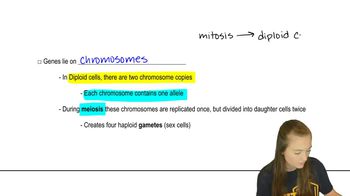Table of contents
- 1. Introduction to Genetics51m
- 2. Mendel's Laws of Inheritance3h 37m
- 3. Extensions to Mendelian Inheritance2h 41m
- 4. Genetic Mapping and Linkage2h 28m
- 5. Genetics of Bacteria and Viruses1h 21m
- 6. Chromosomal Variation1h 48m
- 7. DNA and Chromosome Structure56m
- 8. DNA Replication1h 10m
- 9. Mitosis and Meiosis1h 34m
- 10. Transcription1h 0m
- 11. Translation58m
- 12. Gene Regulation in Prokaryotes1h 19m
- 13. Gene Regulation in Eukaryotes44m
- 14. Genetic Control of Development44m
- 15. Genomes and Genomics1h 50m
- 16. Transposable Elements47m
- 17. Mutation, Repair, and Recombination1h 6m
- 18. Molecular Genetic Tools19m
- 19. Cancer Genetics29m
- 20. Quantitative Genetics1h 26m
- 21. Population Genetics50m
- 22. Evolutionary Genetics29m
17. Mutation, Repair, and Recombination
DNA Repair
Problem 35
Textbook Question
Ataxia telangiectasia (OMIM 208900) is a human inherited disorder characterized by poor coordination (ataxia), red marks on the face (telangiectasia), increased sensitivity to X-rays and other radiation, and an increased susceptibility to cancer. Recent studies have shown that this disorder occurs as a result of mutation of the ATM gene. Propose a mechanism for how a mutation in the ATM gene leads to the characteristics associated with the disorder. Be sure to relate the symptoms of this disorder to functions of the ATM protein. Further, explain why DNA repair mechanisms cannot correct this problem.
 Verified step by step guidance
Verified step by step guidance1
Understand the role of the ATM gene: The ATM gene encodes a protein that is crucial for the repair of DNA double-strand breaks. It is involved in the cell cycle control and activation of DNA repair proteins.
Identify the impact of ATM mutations: Mutations in the ATM gene can lead to a non-functional or absent ATM protein, impairing the cell's ability to repair DNA damage effectively.
Relate ATM dysfunction to symptoms: Without a functional ATM protein, cells accumulate DNA damage, leading to increased sensitivity to radiation (as DNA damage from radiation cannot be repaired) and a higher risk of cancer due to genomic instability.
Connect ATM dysfunction to neurological symptoms: The ATM protein is also involved in neuronal development and function. Its dysfunction can lead to neurodegeneration, explaining the ataxia (poor coordination) observed in patients.
Explain the failure of DNA repair mechanisms: Since the ATM protein is a key regulator of the DNA damage response, its absence or malfunction means that the signaling pathways required to initiate and coordinate DNA repair are disrupted, preventing effective repair of DNA damage.
Recommended similar problem, with video answer:
 Verified Solution
Verified SolutionThis video solution was recommended by our tutors as helpful for the problem above
Video duration:
4mPlay a video:
Was this helpful?
Key Concepts
Here are the essential concepts you must grasp in order to answer the question correctly.
ATM Gene and Protein Function
The ATM (Ataxia Telangiectasia Mutated) gene encodes a protein that plays a crucial role in the cellular response to DNA damage, particularly in the repair of double-strand breaks. This protein is involved in signaling pathways that activate cell cycle checkpoints and DNA repair mechanisms, ensuring genomic stability. Mutations in the ATM gene can impair these functions, leading to the symptoms of ataxia, telangiectasia, and increased cancer risk due to the accumulation of unrepaired DNA damage.
Recommended video:
Guided course

Proteins
DNA Repair Mechanisms
DNA repair mechanisms are cellular processes that correct damage to the DNA molecule, maintaining genomic integrity. Key pathways include homologous recombination and non-homologous end joining, which are activated in response to DNA breaks. In individuals with ATM mutations, these repair pathways are compromised, leading to an inability to effectively repair DNA damage, which contributes to the development of cancer and other symptoms associated with Ataxia telangiectasia.
Recommended video:
Guided course

Repair Pathways
Genetic Inheritance and Disorders
Ataxia telangiectasia is inherited in an autosomal recessive manner, meaning that an individual must inherit two copies of the mutated ATM gene (one from each parent) to express the disorder. This genetic inheritance pattern is significant in understanding the risk of the disorder in families and the potential for carrier status. The relationship between genotype (the genetic makeup) and phenotype (the observable characteristics) is crucial for comprehending how mutations lead to specific clinical symptoms.
Recommended video:
Guided course

Diploid Genetics

 1:45m
1:45mWatch next
Master DNA Proofreading with a bite sized video explanation from Kylia Goodner
Start learning



